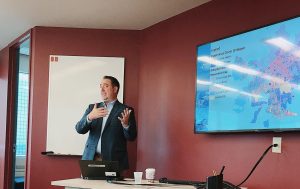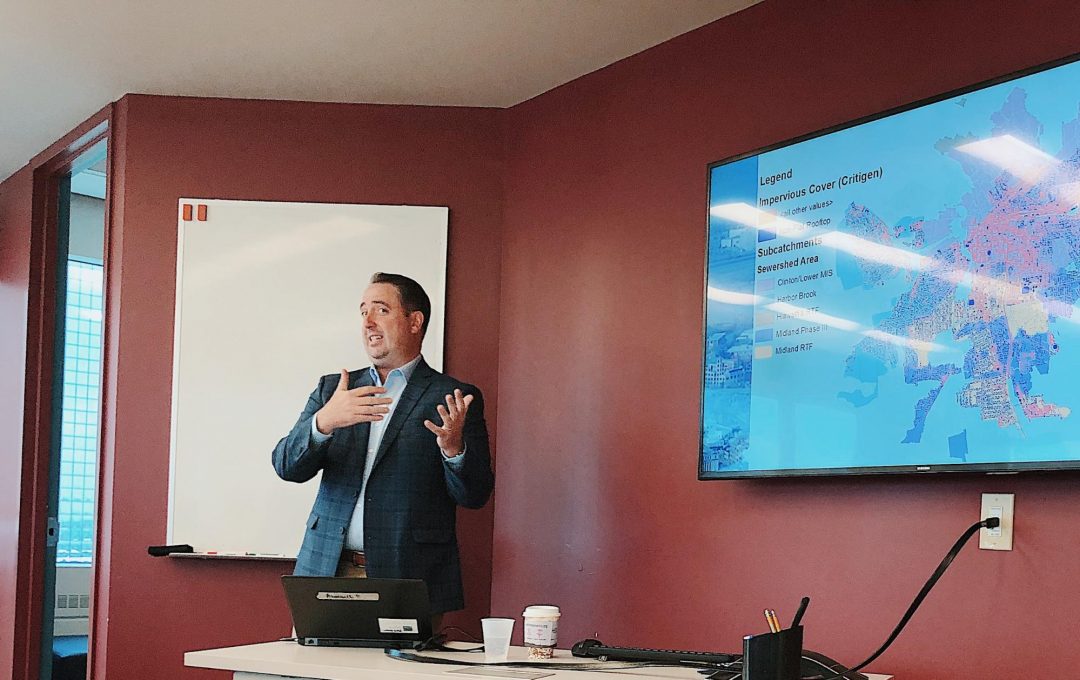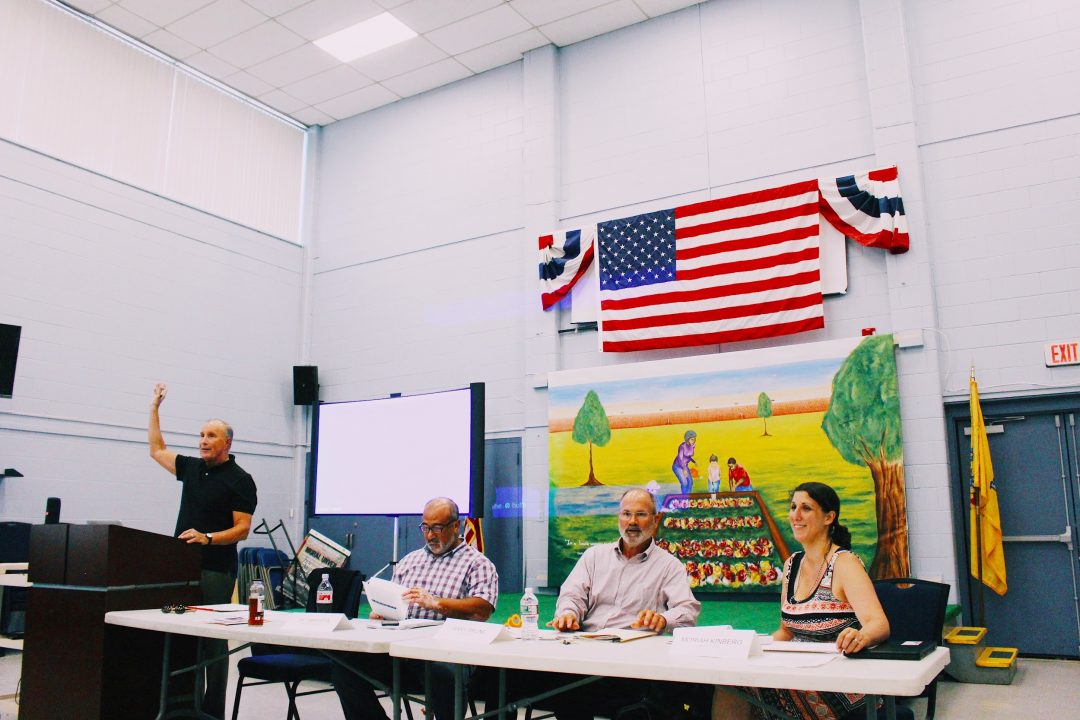Onondaga County, New York, found itself in an exciting position in 2012. Struggling, as many cities and towns are to reduce combined sewer overflows (CSOs), Onondaga county was going to use an all gray infrastructure approach, until Joanie Mahoney, then County Executive, stepped in to recommend a newer approach to the issue in the form of green infrastructure.
Though green infrastructure was gaining traction, it was not yet readily accepted as a viable solution by municipalities and towns. In fact, it wasn’t until Mahoney read NRDC’s Rooftops to Rivers: Green Strategies for Controlling Stormwater and Combined Sewer Overflows that she began to recognize the plethora of benefits possible with green infrastructure. Despite considerable obstacles standing in the way of convincing the public and municipalities of the efficacy of green infrastructure, New York Water Environment Association Government Affairs Committee Chair Matt Millea and Mahoney both recognized that the journey toward successfully implementing green infrastructure in Onondaga County would begin with ambitious thinking about the possibility of a green Syracuse.
As part of its Save the Rain program, Onondaga hit the ground running and installed green roofs, cisterns, and permeable parking lots. These alternatives quickly became conversation pieces and points of public introduction to green infrastructure; most notable, perhaps, was the use of recycled rainwater for ice at Syracuse’s War Memorial hockey rink. After demonstrating the efficacy of green infrastructure through its completed projects, both as a tool for reducing CSOs and as a tool for public engagement, Syracuse began the journey of widespread implementation, going on to successfully construct green public parks, parking lots, and city streets with features like bioswales, permeable pavement, and rain gardens in city sidewalks.
Syracuse’s success is also owed in part to the use of the EPA’s Storm Water Management Model (SWMM), a tool that allows municipalities to measure the type and amount of runoff from a sewer system. Using SWMM, Onondaga County was able to select ideal locations for GI and quantitatively demonstrate that, in combination with gray infrastructure, green infrastructure was an ideal way to tackle CSOs.
 As a result of extensive efforts using SWMM and city buildings to shift public opinion on how CSO events might be tackled, Syracuse and Onondaga County have ended up with a cleaner and healthier Onondaga Lake, which now attracts more fishers, bald eagles, and boaters than in any time in recent memory. In fact, Onondaga Lake now even attracts performers and the community-at-large to the recently completed St. Joseph’s Health Amphitheater, a lakeside venue that is thriving due to the renewed cleanliness of the body of water upon which it rests. Let Syracuse and Onondaga County be an example; if we push for green solutions to CSOs, in combination with gray solutions, our communities will not only be greener, but also cleaner and more unified.
As a result of extensive efforts using SWMM and city buildings to shift public opinion on how CSO events might be tackled, Syracuse and Onondaga County have ended up with a cleaner and healthier Onondaga Lake, which now attracts more fishers, bald eagles, and boaters than in any time in recent memory. In fact, Onondaga Lake now even attracts performers and the community-at-large to the recently completed St. Joseph’s Health Amphitheater, a lakeside venue that is thriving due to the renewed cleanliness of the body of water upon which it rests. Let Syracuse and Onondaga County be an example; if we push for green solutions to CSOs, in combination with gray solutions, our communities will not only be greener, but also cleaner and more unified.



 On Wednesday, July 17th, community representatives, among them Mayor Wilda Diaz, Council President Bill Petrick and Vanessa Bermudez of the Zoning Board, met at a local community center to come to a mutual understanding of the issue. Moderated by Harry S. Pozycki (Chairman and Founder of the Citizens Campaign) and led by panelists Dr. Christopher Obropta (PhD in Civil Engineering, specialist in water resources at Rutgers, and expert in gray infrastructure), Gary Brune (New Jersey Future stormwater utilities program manager), and Moriah Kinberg (New Jersey Future, Community Outreach Manager and organizer of of Sewerage Free Streets and Rivers Campaign), the group discussed the many proposed solutions to CSOs and their ramifications within the city. The panel discussed the roles of green and gray infrastructure in the solutions. Green Infrastructure solutions mimic nature by capturing stormwater and then slowly releasing it into the ground, while grey infrastructure uses pipes, storage tanks and tunnels as well as sewer treatment plan expansion to capture and treat the mixture of stormwater and sewage. Green infrastructure is unique in its ability to help solve the issue cost effectively and for the added community benefits ranging from neighborhood beautification to cooler, shaded, sidewalks. Perth Amboy will not be the first city to implement strategies for solving stormwater issues, and this too gives the city the advantage of being able to implement proven strategies, rather than spending money on speculative ones. One such proven strategy that is up for consideration is the creation of a stormwater utility, which is a more equitable way to fund stormwater infrastructure upgrades. Rather than relying on property taxes or sewer fees that are not related to polluted runoff, a stormwater utility is directly related to the amount of stormwater that runs off your property and can only be used for stormwater infrastructure. In addition to funding, concerns relating to public outreach and zoning were also addressed, as any plan put in place to mitigate stormwater cannot be enacted without the involvement of the public who will be dealing with the construction of these CSO solutions, which could possibly involve the use of private property.
On Wednesday, July 17th, community representatives, among them Mayor Wilda Diaz, Council President Bill Petrick and Vanessa Bermudez of the Zoning Board, met at a local community center to come to a mutual understanding of the issue. Moderated by Harry S. Pozycki (Chairman and Founder of the Citizens Campaign) and led by panelists Dr. Christopher Obropta (PhD in Civil Engineering, specialist in water resources at Rutgers, and expert in gray infrastructure), Gary Brune (New Jersey Future stormwater utilities program manager), and Moriah Kinberg (New Jersey Future, Community Outreach Manager and organizer of of Sewerage Free Streets and Rivers Campaign), the group discussed the many proposed solutions to CSOs and their ramifications within the city. The panel discussed the roles of green and gray infrastructure in the solutions. Green Infrastructure solutions mimic nature by capturing stormwater and then slowly releasing it into the ground, while grey infrastructure uses pipes, storage tanks and tunnels as well as sewer treatment plan expansion to capture and treat the mixture of stormwater and sewage. Green infrastructure is unique in its ability to help solve the issue cost effectively and for the added community benefits ranging from neighborhood beautification to cooler, shaded, sidewalks. Perth Amboy will not be the first city to implement strategies for solving stormwater issues, and this too gives the city the advantage of being able to implement proven strategies, rather than spending money on speculative ones. One such proven strategy that is up for consideration is the creation of a stormwater utility, which is a more equitable way to fund stormwater infrastructure upgrades. Rather than relying on property taxes or sewer fees that are not related to polluted runoff, a stormwater utility is directly related to the amount of stormwater that runs off your property and can only be used for stormwater infrastructure. In addition to funding, concerns relating to public outreach and zoning were also addressed, as any plan put in place to mitigate stormwater cannot be enacted without the involvement of the public who will be dealing with the construction of these CSO solutions, which could possibly involve the use of private property.